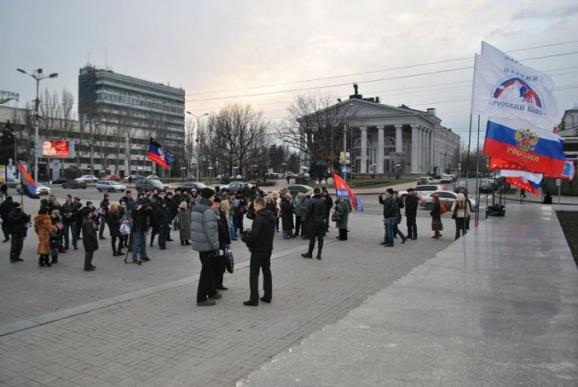At a time when pro-Russian activities continue to take place in the Donetsk, Luhansk and Kharkiv areas, Espreso TV has decided to debunk a few myths that have managed to form in mass consciousness, most notably in the mass media of "brotherly" Russia.
Myth #1: Separatist leaders in Eastern Ukraine are local and have popular support
All separatist activity in the Eastern regions follows the same scenario, which more or less follows the one used in Crimea: demonstrators under the Russian flag choose so-called "people's governors." But in the absence of real public support, these "people's governors" are individuals who not only lack authority on the regional level, but who also are completely unknown to the general public.
The first such pseudo-governor was a certain 29-year-old Pavlo Hubaryev. His biography has already appeared in the Russian Wikipedia and tells of a heroic struggle for the "Russian idea," starting in 2004, as well as participation in Natalia Vitrenko's Progressive Socialist Party of Ukraine. However, it appears the Hubaryev character had no authority even in Vitrenko's political group, which specializes in political clowning and is known primarily for the idiotic declarations of its exalted leader.
The main occupation of this Hubaryev was managing a company that organized New Year's parties for children. In other words, the "people's governor" worked as a hired Santa Claus -- an occupation, which while not at all shameful, certainly does not indicate great authority and social prestige.
After Hubaryev's arrest, the Donetsk separatists put forward another "people's governor" -- Denys Pushylin
, an employee of a commercial organization called "Sweet Life." This separatist is known only for his past activity as head of one of the divisions of the notorious MMM financial pyramid in Ukraine. So the "people's governor" continues to work for thieves. It's just that earlier he worked for Russian economic thieves. Now the scale of his employers has increased somewhat -- he is working for political thieves.
In the Luhansk region, the separatists elected as "people's governor" a similarly unknown person-- Oleksandr Kharytonov, leader of the "Luhansk Guard." Like his "colleague" Hubaryev, Kharytonov also comes from Vitrenko's party, whose ratings have long been within the margin of statistical error. Therefore, it is not surprising that most people in Luhansk never even suspected that such a politician existed.
The "people's governor" of the Kharkiv region is somewhat better known in his region, but certainly not for his positive qualities. Ihor Masalov, the "people's governor" of the Kharkiv region, is the head of the "Honor and Dignity" front and the director of the "Kremlin Strategy" center. This individual, a former Komsomol member, is now a member of the Party of Regions and an activist in Viktor Medvedchuk's "Ukrainian Choice." In Kharkiv, Masalov is known primarily for heading up the joint stock company "Salamander," in actuality a financial pyramid through which, as local media reported, Masalov cheated some 100,000 people. Additionally, Masalov managed a funeral services business. Therefore, this "people's governor" turns out to be a common crook and undertaker. However, his connection with the "Medvedchuk choice" obviously speaks for itself.
Myth # 2: The movement to join Russia has broad popular support
The Russian mass media, in addition to other lies, is actively spreading the myth that most of the population in Southeastern Ukraine is waiting impatiently for Putin, the liberator on a tank, while dreaming of a reunion with brotherly Russia. The reality indicates something quite different. Most of the opinion polls have demonstrated that the idea of uniting with Russia is supported only by a minority of the population in Southeastern Ukraine, even in occupied Crimea. This is why Putin's popular support for the "referendum" in Crimea was possible only because of Russian troops.
To realize that the separatists do not have broad support in the Southeast, it suffices to look at the number of participants in the pro-Kremlin rallies -- they rarely exceed 1,000 people, which is not a lot for cities with populations of a million --Donetsk and Kharkiv -- but also for Luhansk, which has a population of almost half a million. Therefore, the "massive" pro-Russian rallies in Donetsk on average attract 0.1% of the population. In Donetsk, one could speak of a massive movement if 100,000 people came out on the street, or even 50,000. However, protests numbering 1,000 to 1,500 participants point to large-scale provocations rather than a broad popular movement. Even among these people, "tourists" from a neighboring state are widely represented.
Therefore, the available human resources for Putin's puppets are very limited and sufficient to provoke unrest only in three oblasts simultaneously. Putin's plan for a "Russian Spring" in the entire Southeast has apparently failed, which is why the separatists are concentrating their efforts only on three key areas that have become a sort of Russian springboard for further Russian advances: the Donetsk, Luhansk and Kharkiv oblasts.
Myth # 3: Law enforcement is conniving with the separatists
Lately it is a rare person who fails to criticize law enforcement for its imitation of counteraction against the separatists, especially after events in Donetsk and Kharkiv, where people were injured and even killed. However, it must be understood that Ukrainian law enforcement has to deal with the separatists while taking into account the enormous forces of the Russian army, which are concentrated in the immediate vicinity of the "hot" border areas. One must not forget that large-scale actions to disperse the separatist rallies can become an excellent pretext for invasion by the neighbor's troops in order to "protect the Russian-speaking population." This is exactly why law enforcement has adopted the tactic of bloodless suppression of separatist activity.
Also, one must not forget that every day police are detaining separatist activists and that the "national governors" Hubaryev and Kharytonov have been residing in prison for some time. Additionally, law enforcement has managed to establish some control over the tourist-separatists arriving through the rather leaky Russian-Ukrainian border.
Therefore, law enforcement carefully but systematically is trying to negate the separatist efforts of the Kremlin while being careful not to provoke violent confrontations or even military aggression in the country.



